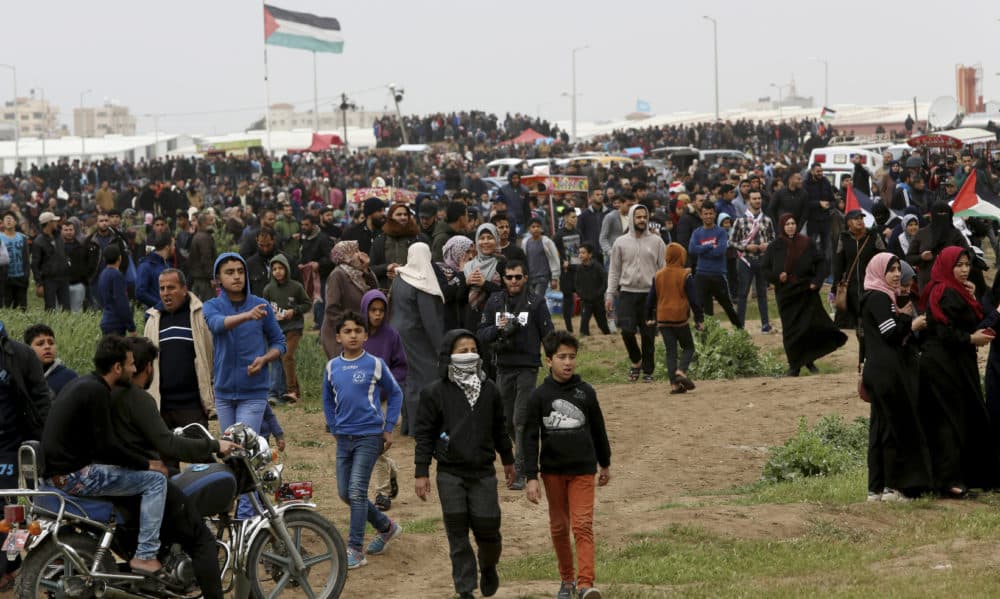Advertisement
Commentary
Americans Should Know More About The 'March Of Return'

While Israeli politics, including the recent election between Benjamin Netanyahu and Benny Gantz, was covered widely by the U.S. news media, another event central to peace and justice in the region was taking place a stone’s throw from Tel Aviv: the March of Return.
Gazan journalist and poet Ahmed Abu Artema inspired the protest movement in January 2018, when he pondered, on Facebook, about what might happen if Gazans marched peacefully to the Israeli border fence with the keys to their homes and Palestinian flags in hand, to demand an end to the Israeli blockade. He was surprised at the response.
Thousands of Gazans marched in what became weekly Friday protests, and the “Great March of Return and Breaking of the Siege” was born. Gazans of all ages, all walks of life and all political factions joined in. Speaking at Harvard Law School in February, Abu Artema reflected on the high cost of the March and Palestinians’ determination to continue it by saying: “We have no choice.”
I was a senior Fulbright fellow in Jerusalem, taught at Al Quds University, lectured at Birzeit University and know people, including former students, human rights academics and colleagues in Gaza. Those of us with friends and close connections in Gaza watch and worry about their fate, with news of deaths and injuries every day.
The U.S. has given and continues to give more military and financial assistance to Israel than any other country in the world. As journalist Peter Beinart wrote in Jewish Forward, “What distinguishes American aid to Israel is precisely its exemption from the rules and limitations that govern assistance to other nations ...” such as the Foreign Assistance Act of 1961, which prohibits U.S. aid to countries that engage in “gross violations of internationally recognized human rights.”
The Trump administration’s current budget proposal is for 61% of U.S. foreign military financing to go to Israel. The United Nations, human rights experts and international human rights organizations have said that Israel has been carrying out gross violations of human rights against demonstrators and the civilian population in Gaza. For any other country, such a finding would likely require immediate termination of all U.S. aid.
Gazans of all ages, all walks of life and all political factions joined in.
Why are thousands of people demonstrating? The majority of Gazans, 75%, are refugees or descendants of the 750,000 Palestinian refugees expelled from the land in 1948, by the newly declared state of Israel. Since the early 1990s, following the first Intifada and the first Gulf War, Israel has imposed increasing restrictions on the lives of Gaza’s people, including on their freedom of movement and their ability to obtain basic goods and services.
In June 2007, following the elections that brought Hamas to power, Israel imposed a blockade on the 2 million people in Gaza, containing them in a small strip of land 40 km long with no means of access to the outside world, except as Israel permits. As a result, Gaza's unemployment rate is 52%, with two-thirds of young people unemployed. Sixty-eight percent of the population is food insecure and dependent on international aid.
The Israeli government claims its restrictions are based on security concerns, and that it has no obligation to permit entry and egress from Gaza for any but exceptional humanitarian reasons. The Netanyahu government says the siege is intended to stop weapons from entering Israel from Gaza. It’s a position that has been severely criticized and refuted by the international human rights community, including Amnesty International and Human Rights Watch.
Advertisement
Those of us with close connections and access to authoritative and first-hand reports from people on the ground are also keenly aware of the propaganda that distorts what Americans learn about the facts about the situation in Gaza; separating fact from fiction is not easy. However, there is sufficient reporting from eyewitnesses and experts from the United Nations to draw the conclusions I draw here.
The March of Return and Israel’s response to it should engender far more attention and publicity in the U.S. than it has thus far ...
Israel’s response to the March of Return is to use overwhelming force against civilians. One casualty was Razan Najar, a 20-year-old member of the Palestinian Medical Relief Society. She was shot in the chest by an Israeli sniper while wearing her white paramedic coat standing about 100 meters from the border fence. She died at the hospital. Her mother delivered an anguished call to continue the March: “I see my daughter Razan in the eyes of every young Palestinian.” In a single day, on May 14, 2018, the Israeli Defense Forces killed six children.
During this same time period, according to the U.N. Special Commission of Inquiry (COI), there were no civilian deaths or injuries of Israelis, within Israel, due to the Gazan demonstrations. The COI Report found that four Israeli soldiers were injured as a result of the demonstrations, but none died. It further found that since the marchers in Gaza are civilian demonstrators, engaging in neither combat nor military operations, the IDF’s use of live ammunition against them are war crimes.
Meanwhile, the U.N. Office of Human Rights and Humanitarian Affairs reported that 23,313 Palestinian demonstrators were injured in 2018 by Israeli Defense Forces, including by tear gas inhalation and canisters. These statistics were included in COI's findings.
The March of Return and Israel’s response to it should engender more attention and publicity in the U.S. than it has thus far, particularly in light of the Trump administration’s request for more aid to Israel. As Abu Artema wrote in an essay published by Al Jazeera, “The Great March of Return is the response of a proud nation to decades of occupation, aggression and theft. By taking this peaceful stand, we are announcing to the world that despite Israel’s attempts to wipe us out, we are still standing strong and united.”
Americans must take heed and challenge the unrestricted use of our tax dollars that is funding violations of Gazans' freedom, and their right to march for their lives and dignity.

